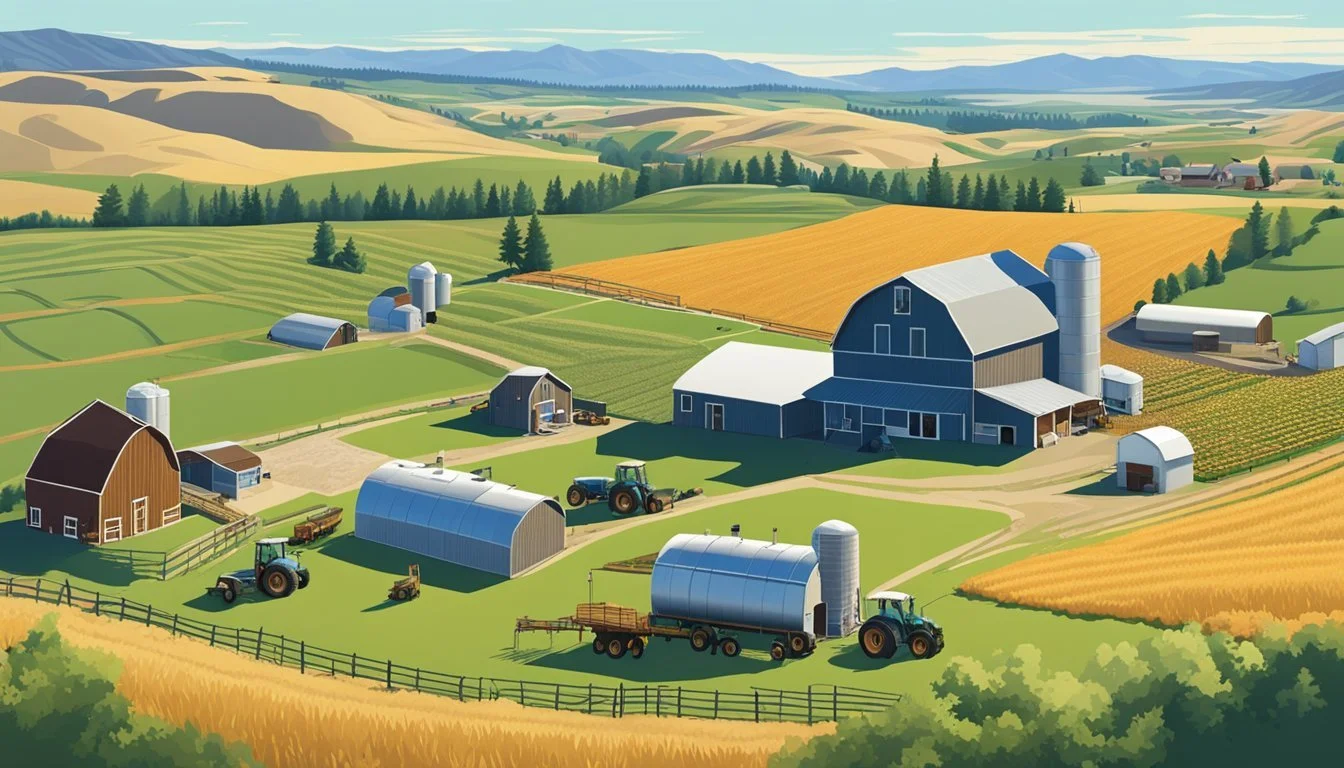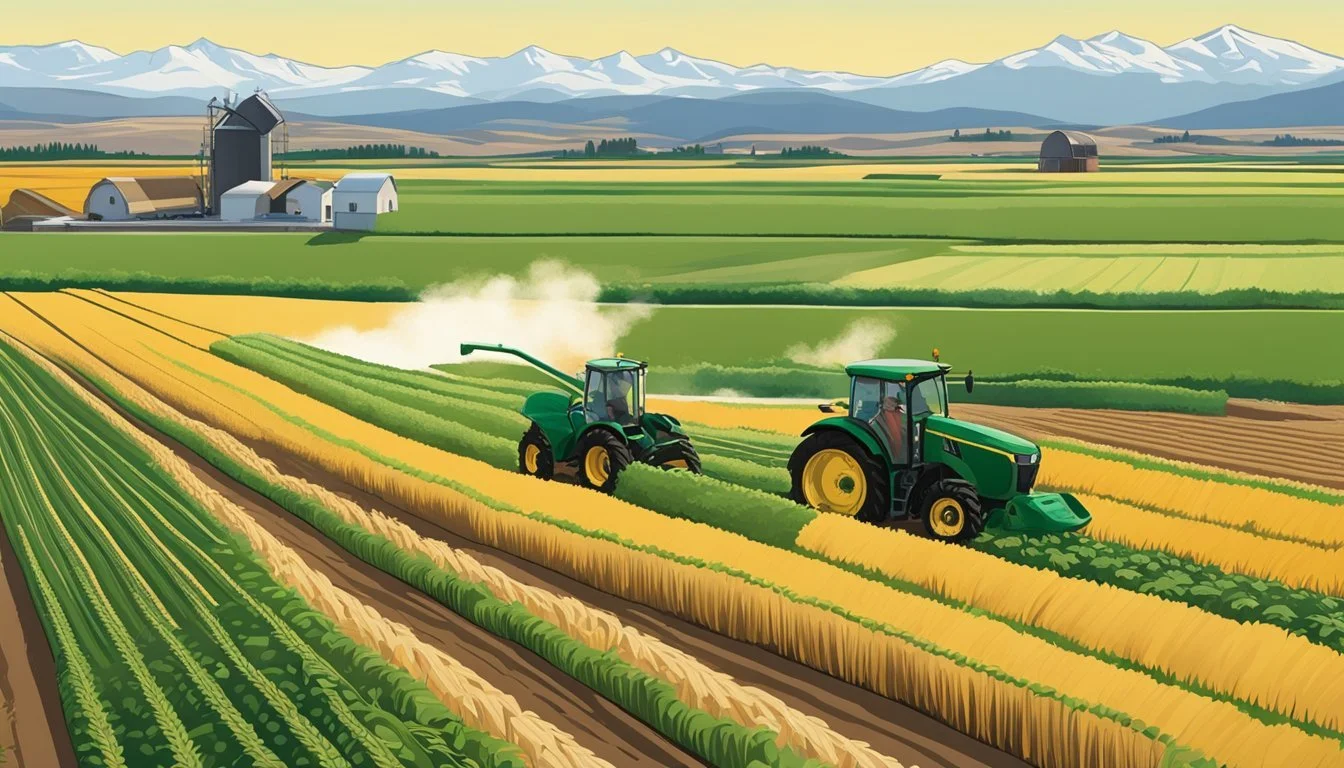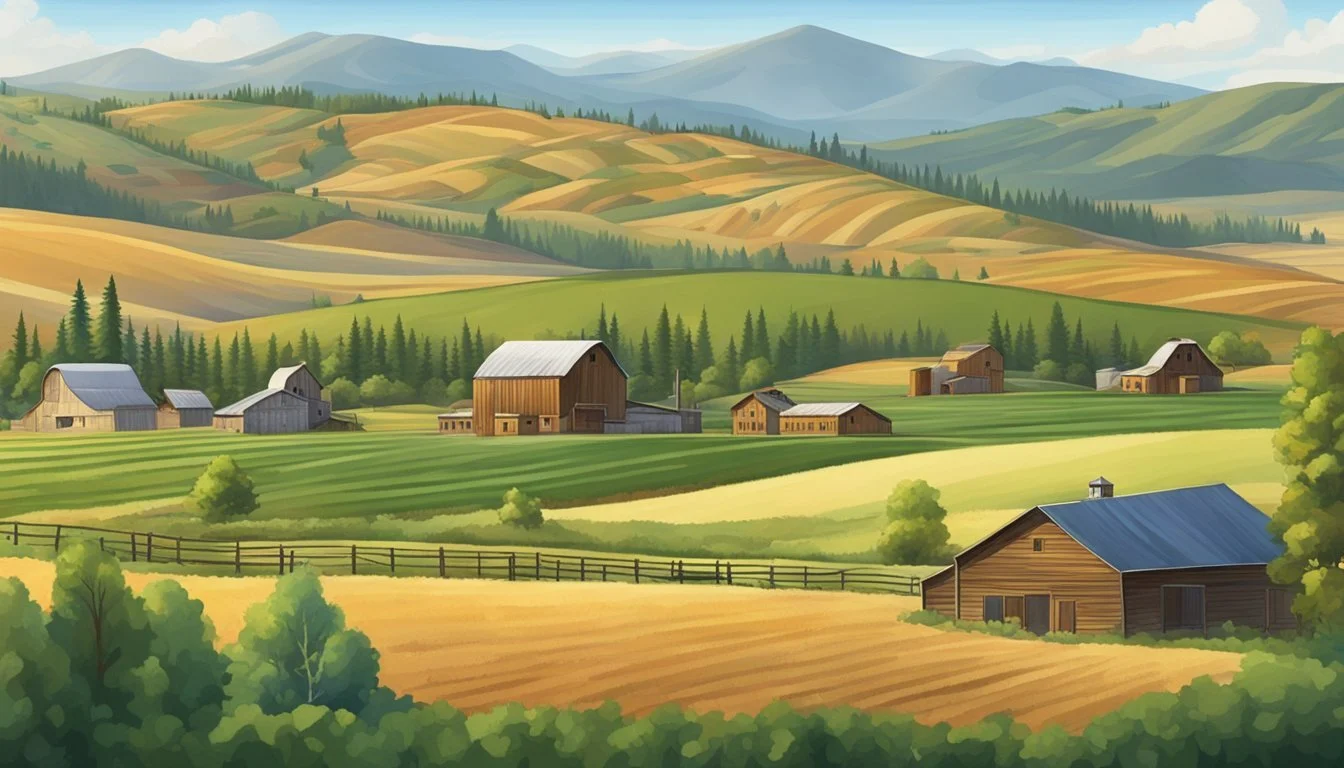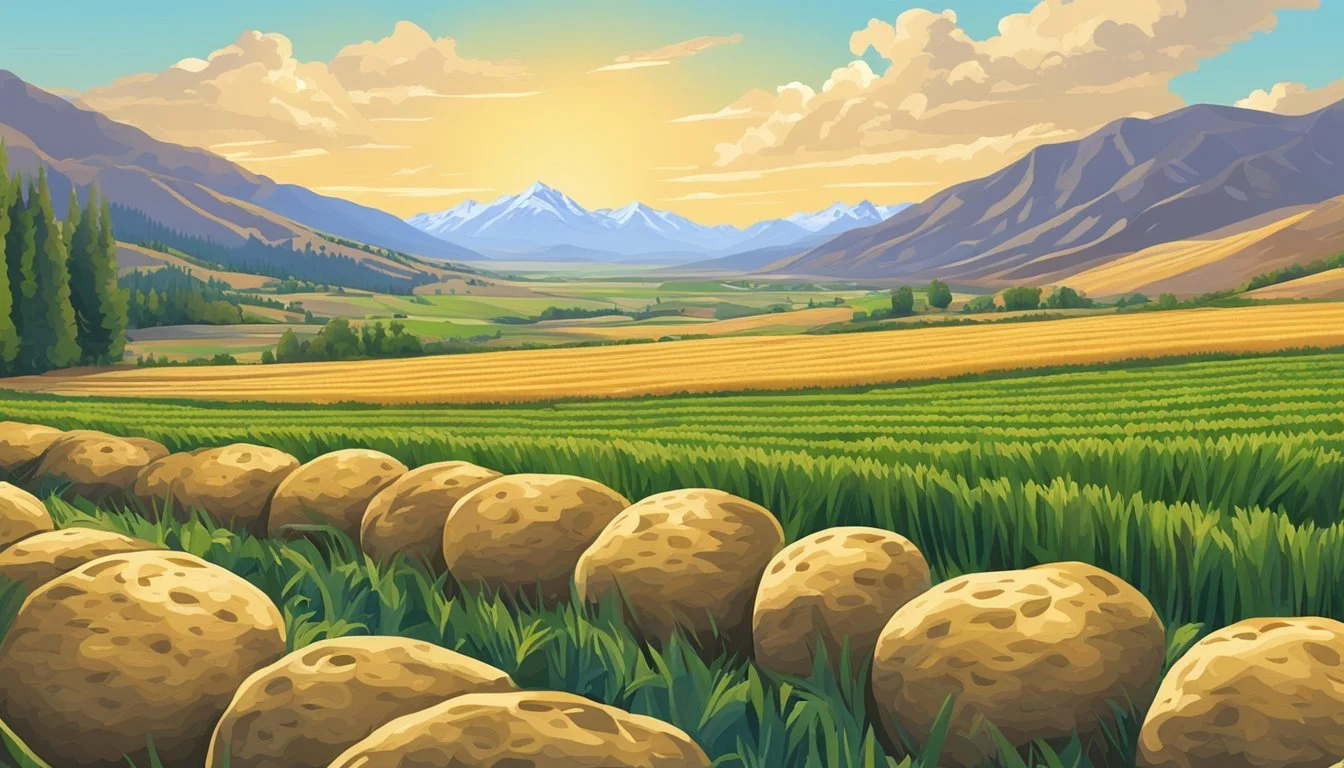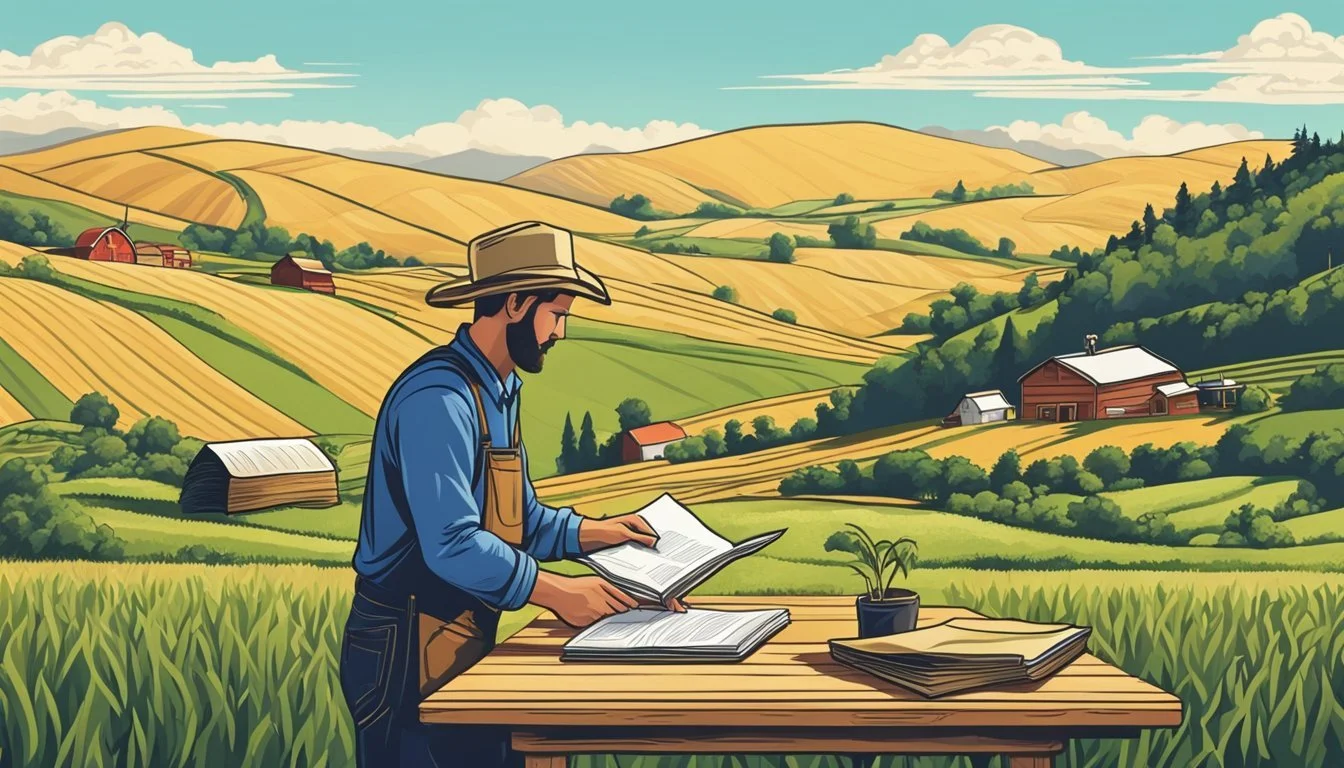Guide to Farming in Idaho
Essential Tips for Successful Agriculture
This Article is Part of Our State by State Farming Guide
Idaho's agricultural sector is a significant contributor to both the state's economy and to the entire United States. Known for its rich volcanic soil, clear mountain water, and a growing season that ranges in length depending on the region, Idaho provides an ideal environment for a variety of agricultural operations. The state leads the nation in potato production, supplying nearly one-third of America's potatoes. Besides potatoes, Idaho's farms produce a range of crops and livestock on its vast farmland, which encompasses millions of acres across the state.
The farming landscape in Idaho is diverse, from small urban farming operations to large business-oriented agricultural enterprises. Small acreage farming has a longstanding tradition in Idaho, allowing individuals the opportunity to produce food and develop various farm-based business ventures. Consistent growth in areas such as poultry production for profit, mushroom cultivation, and goat rearing highlights the adaptability and breadth of Idaho farming. These operations are supported by a range of resources, including educational courses and internships, which aim to guide new and beginning farmers toward a successful agricultural career in the state.
Agriculture in Idaho is not only about the practical aspects of planting and harvesting but also involves strategic business planning and understanding of the market. Resources like AgPlan can help farmers at any level of expertise to develop a robust business plan tailored to their specific agricultural endeavors. Meanwhile, the state's small farm education programs, often part of larger initiatives like Cultivating Success, aim to empower farmers with knowledge on whole farm planning, bird nutrition, housing and meat processing, further emphasizing the crucial combination of hands-on production skills and savvy business acumen.
Agricultural Profile of Idaho
Idaho's agriculture is characterized by its diversity and significant contribution to the U.S. food system, underpinned by a large number of farms and an array of commodities, particularly potatoes, for which the state is renowned. It is a pillar of the local economy, providing income to local communities and utilizing extensive acreages for production.
Key Crops and Commodities
The agricultural landscape of Idaho is best known for its potato production, with the state leading the nation and accounting for about one-third of the U.S. output. Idaho's farmland is also used for cultivating other major crops such as wheat and barley, adding variety to the state's agricultural output. Beans are another essential crop that enriches the agricultural tapestry of Idaho, ensuring the state's position in the top ranks for multiple commodities.
Potatoes: Nearly 1/3 of all U.S. potatoes
Wheat & Barley: Significant crops for diversification
Beans: Among the array of commodities produced
Land Access and Utilization
Idaho utilizes an extensive area for farming operations, close to 25,000 farms, which successfully manage and cultivate the land. With advanced irrigation systems and suitable climatic conditions, the state maintains high levels of productivity over its ample farmland. Efficient use of technology and transportation networks optimizes land use and supports the varied agricultural activities across the state.
Farm Operations: ~25,000
Acres: Over 300,000 acres dedicated to potato cultivation
Economic Impact on Local Communities
Agriculture forms the backbone of Idaho's economy, affecting local communities extensively. It secures the state a high rank in net farm income in the Western U.S., underscoring its economic significance. The success and profitability of Idaho's agriculture, including sales from smaller farms, are a testament to the community's skills and the pivotal role the sector plays in sustaining the local economy.
Economic Role: Second in the West for net farm income
Community Support: Providing employment and fostering skills
Overall, the agricultural sector in Idaho thrives due to a combination of fertile land, crop diversity, and strategic support from technology and community, which together drive the state's economic prosperity.
Starting a Farm in Idaho
Starting a farm in Idaho requires careful planning, access to resources, and a good understanding of the state's agricultural landscape. Beginning farmers should focus on creating a robust financial plan and securing the necessary resources including land, seeds, and water.
Steps for Beginning Farmers
Research and Planning: Prospective farmers must thoroughly research the types of crops and livestock suited to Idaho's climate. Resource Utilization: The Land Conservation Assistance Network and other local organizations offer training and articles to navigate initial hurdles.
Identify crop options and livestock suited to local conditions.
Seek local training programs to gain agricultural knowledge.
Securing Resources and Capital
Financial Assistance: Several programs provide financial help to beginners. Land Access and Acquisition: Accessing land can be managed through leasing options or direct purchases.
Explore USDA financial assistance programs for beginners.
Consider leasing land or look for land purchase opportunities.
Small Farm Considerations
Market Opportunities: Many Idaho farms are small-scale and have direct sales to consumers. Sustainability: Small-scale operations should consider sustainable practices, especially in water utilization.
Emphasize direct sales channels for farm products.
Implement water-saving techniques suited to Idaho's environment.
Farm Management Practices
Effective farm management practices are essential for the success and sustainability of agriculture in Idaho. They involve optimizing soil health, utilizing efficient irrigation methods, fostering sustainable agricultural techniques, and integrating livestock and crops to create a balanced and productive farm ecosystem.
Soil Health and Irrigation
Good soil health is the foundation of any farming operation. In Idaho, managing soil involves:
Regular soil testing to determine nutrient needs.
Organic matter addition, such as compost, to improve soil structure and fertility.
Crop rotation to minimize soil-borne diseases and optimize nutrient use.
Irrigation is vital due to Idaho's varying climate. The practice includes:
Drip irrigation, conserving water by directly hydrating plant roots.
Sprinkler systems, which can be tailored to the specific needs of a crop.
Flood irrigation is less common but still used for certain field crops.
Sustainable Agriculture
Sustainable agriculture in Idaho focuses on:
Conservation tillage, reducing soil erosion and preserving soil moisture.
Cover cropping to suppress weeds, prevent soil compaction, and enhance soil health.
Integrated pest management (IPM), which utilizes strategies to control pests with minimal environmental impact.
The Nature Conservancy in Idaho also emphasizes regenerative agricultural practices that build soil health and support ecosystems.
Livestock and Crop Integration
Integrating livestock with crops can be beneficial:
Livestock grazing on cover crops or crop residue improves soil health through manure and trampling action, which can incorporate organic matter into the soil.
Crop diversification benefits livestock by offering a variety of forage, and it benefits crops through improved soil conditions.
Using livestock to manage crop residues and cover crops can reduce reliance on chemical inputs and enhance the cycling of nutrients within the farm.
Production Methods
In Idaho, farmers adopt diverse production methods to ensure the efficient growth of crops, balance economic demands, and comply with food safety regulations. These methods vary from traditional techniques to innovative technologies that enhance productivity and sustainability.
Conventional vs Organic Farming
Conventional Farming in Idaho usually incorporates standard practices such as the use of synthetic fertilizers and pesticides. These techniques focus on maximizing productivity and are typically used in large-scale potato production, which is a leading crop in the state. On the other hand, Organic Farming has also gained ground, with farmers avoiding synthetic inputs and adhering to natural processes. Organic methods can increase biodiversity and reduce chemical runoff, impacting the produce quality and the environment positively.
High-Tech Farming Solutions
Technological advancements have led to high-tech solutions in Idaho’s agricultural scene. Farmers deploy Technology such as GPS-guided tractors, automated irrigation systems, and drones for field monitoring. The Seed Industry has evolved as well, using biotechnology to enhance seed quality and resistance to diseases. Precision agriculture tools allow farmers to use resources more efficiently, which is crucial for both Food Safety and environmental sustainability.
Seasonal Planting Guide
A farmer's Garden in Idaho follows a Seasonal Planting Guide to optimize crop yield. Planting schedules are designed around Idaho's climate, with spring and fall being key planting windows for a variety of Produce. Farmers must consider frost dates, soil temperature, and elevation differences across the state. Crop rotation and intercropping can prevent soil depletion, manage pests, and increase the diversity of produce throughout the year.
Marketing and Sales
In Idaho, farmers are capitalizing on a rich heritage of agricultural production by employing strategic marketing and sales approaches. The effectiveness of their efforts is seen in the delivery of fresh products through both local and national channels, carefully crafted marketing strategies, and the growing trend of direct-to-consumer sales.
Local and National Distribution
Farmers in Idaho understand the importance of establishing a strong distribution network for their products. Local distribution chiefly involves selling goods within the state, leveraging Idaho's preference for fresh, locally-sourced agricultural products. In contrast, national distribution requires compliance with broader legal and logistical standards but opens doors to a larger market, thereby increasing potential sales volume.
Agricultural Marketing Strategies
Marketing strategies for Idaho farms include both traditional methods and digital approaches. Farmers focus on:
Branding: Positioning their products to be synonymous with quality and freshness.
Online Presence: Utilizing websites and social media to expand their market reach.
Effective use of these strategies helps farmers to create a distinguishable image for their products and cultivate a loyal customer base.
Direct-to-Consumer Sales
The direct-to-consumer model in Idaho allows farmers to engage with customers personally. This strategy includes:
Farmers' markets
Community-supported agriculture (CSA) programs
On-site farm stores
These outlets not only heighten the consumer's connection to the source of their food but also allows farmers to retain a greater share of the product's final sales price.
By harnessing a variety of sales and marketing tactics, farmers in Idaho can thrive in a competitive market place, delivering fresh, quality products across different sales channels.
Value-Added Products
Value-added products are a significant avenue for Idaho farmers to enhance their profitability. By transforming raw farm products into goods that are ready for the consumer market, farmers can potentially increase their income and tap into various market segments.
Food Processing and Packaging
Food processing encompasses a broad set of methods to prepare farm products for the marketplace. Idaho farmers engage in washing, cooling, and packing to ensure that their produce meets quality standards and has an extended shelf life. For instance, potatoes, one of the state’s signature crops, often undergo these processes before being distributed.
Packaging is another vital step that adds value and marketability to farm products. Effective packaging solutions not only help in maintaining the quality of the product through transportation but also play a crucial role in branding. Innovative and sustainable packaging can set a product apart in the competitive agricultural market.
Specialty Foods and Organic Markets
The demand for specialty foods and organic produce has grown substantially in Idaho, as consumers increasingly seek out healthful and locally sourced options. Producers respond by crafting unique food items such as artisan cheeses and custom meat cuts, as well as by offering organic fruits and vegetables.
Organic producers in Idaho must adhere to strict guidelines in the cultivation and handling of their products. The organic market values not just the end product, but the environmentally-friendly methods used to grow it. Through direct sales in local markets and organic food circles, these producers are able to fetch a premium price for their commitment to sustainable farming practices.
Idaho's Wine Industry
Idaho's wine industry is growing, with a significant increase in the number of wineries and vineyards. It plays a crucial role in the state's agriculture and economy, while gaining recognition for its diverse grape cultivation and quality wine production.
Grape Cultivation
Idaho offers a favorable climate for grape cultivation, especially in the Snake River Valley where the majority of the state's vineyards are located. They have established three American Viticultural Areas (AVAs), which are designated wine grape-growing regions in the United States distinguished by geographic features. The combination of volcanic soil, high altitude, and a distinct diurnal temperature variation creates an ideal environment for a variety of grape types.
Key grape varieties in Idaho include:
Vinifera grapes like Cabernet Sauvignon, Merlot, and Chardonnay
Hybrids and other varieties adapted to the Idaho climate
Idaho also engages in the cultivation of sweet corn seed, although not directly related to the wine industry, it signifies the state's diverse agricultural practices.
Wineries and Wine Production
The number of wineries in Idaho has seen an uptick, boasting over 60 wineries to date. These wineries are proponents of both traditional and innovative wine-making techniques, producing a wide array of wines from classic reds and whites to unique blends.
Wine Production Facts:
Wineries in Idaho Over 60 Vineyards More than 70 Wine-grape Acreage Approximately 1,300 acres AVAs in Idaho 3
Idaho's wineries are integral to the state's burgeoning tourism sector, offering wine tastings, tours, and direct sales to visitors. Wine production in Idaho not only caters to local consumers but is also an emerging segment in exports. The growth in the wine sector reflects the potential for Idaho's wines to become key players in the national and international wine markets.
Ranching in Idaho
In Idaho, ranching stands as a cornerstone industry, requiring a combination of practical skills and thorough understanding of livestock management. It is instrumental for ranchers to stay informed about effective management practices and meat and dairy production processes to ensure the sustainability and profitability of their ranches.
Managing a Ranch
Successful ranch management in Idaho demands a comprehensive skill set to tackle challenges ranging from animal health to resource allocation. Ranchers typically engage in:
Land Management: Careful stewarding of the land to support grazing, including rotation practices.
Animal Husbandry: Maintaining livestock health through vaccinations, feed management, and breeding programs.
Financial Acumen: Budgeting and financial planning are critical for long-term ranch sustainability.
Resource Acquisition: Securing land with viable soils and water resources is key, as echoed by resources like the Idaho Farm and Ranch Center, which offers aid with succession planning.
Meat and Dairy Production
Idaho ranches contribute significantly to local and national markets with their meat and dairy products. Key aspects of this sector include:
Grass and Grain-Feeding: Ranches like Vogel Farms illustrate a trend in providing all-natural grass and non-GMO grain-fed beef, highlighting a commitment to quality.
Variety of Livestock: While beef is prominent, ranches also raise pork, chicken, turkey, and dairy cattle.
Market Strategies: Ranchers adopt direct marketing to connect with consumers, supported by guides from University of Idaho Extension and the Idaho State Department of Agriculture.
Ranchers are dedicated to delivering quality meat and dairy while maintaining the health of their livestock and the land.
Support and Resources
Idaho offers a breadth of support and resources for farmers, ranging from government-assisted programs to educational materials. These initiatives aim to strengthen agriculture by providing tools and knowledge essential for successful farming.
Government Programs and Assistance
Federal and State Assistance:
Farmers in Idaho can benefit from the Conservation Reserve Program, which helps in reducing soil erosion, enhancing water quality, and providing wildlife habitats. This program incentivizes farmers to convert sensitive lands into conservation reserves.
Local Assistance:
County-specific agencies provide localized support, catering to the needs of agricultural producers. For instance, each area, such as Boise, Nampa, or Twin Falls, has different resources tailored to the region's unique agricultural challenges and products.
Educational Resources and Publications
Farm Answers Library:
A compendium of knowledge is available through the Farm Answers Library, featuring over 5,400 resources. This includes:
Apps and Online Courses: For convenient, on-the-go learning.
Audio and Video Materials: To cater to different learning preferences.
Written Publications: Extensive guides and articles covering a wide range of agricultural topics.
Cultivating Success™ Program:
This educational initiative is dedicated to enhancing local farming systems through educational and experiential opportunities. It aims to create strong communities equipped with necessary farming skills and resources in Idaho.



